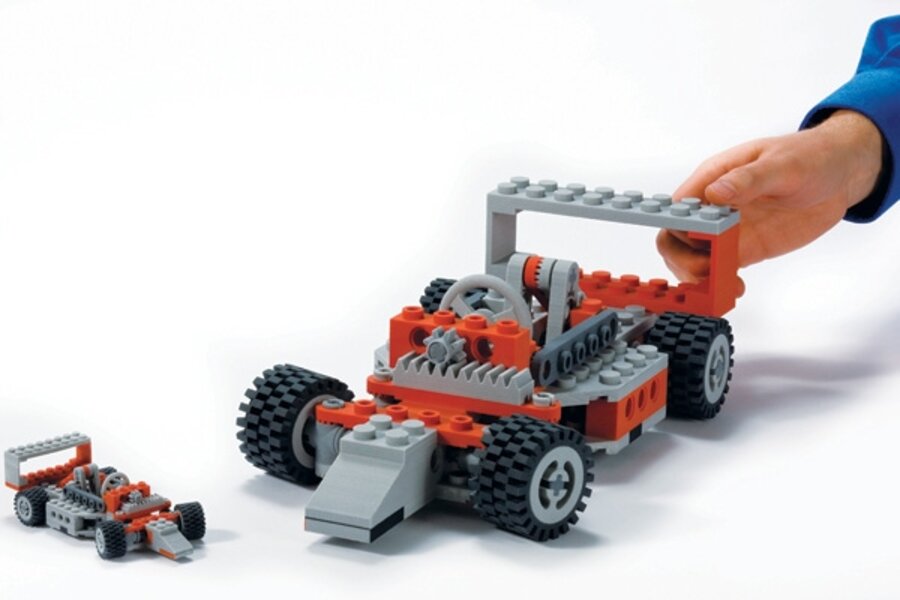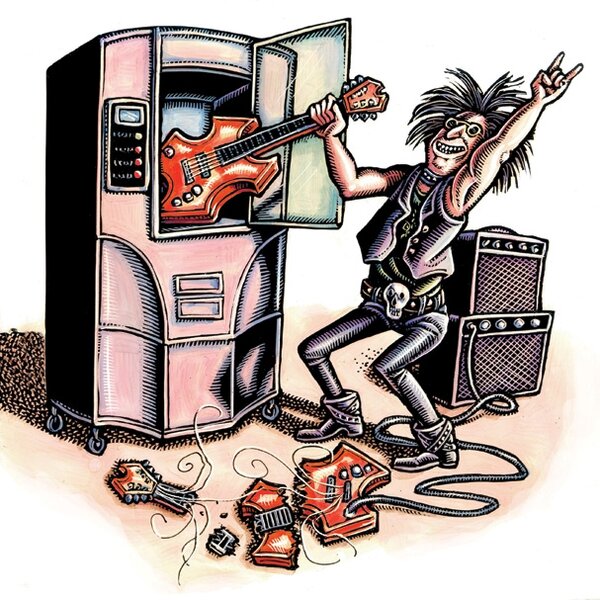Your idea, "printed" in 3-D
In television’s “Star Trek,” the crew used “replicators” to instantly create anything from Earl Grey tea to engine parts. For modern science, that remains something of a frontier. But Z Corporation in Burlington, Mass., is working on a real-world variation that comes stunningly close.
The company stands among the early players in 3-D printing, in which engineers load up a schematic of what they want, feed in some plastic, and watch a machine print out a fully formed model – complete with moving parts.
At its heart, this style of “rapid prototyping” relies on a simple concept: building an object one cross section at a time, similar to laying down LEGO bricks to make a larger shape.
The field is still very young, says Scott Harmon, vice president of business development at Z Corporation. Several companies make these three-dimensional printers, the cheapest of which sells for about $10,000.
Despite a wide array of potential uses, interest and investment has been slow because “even designing a door hinge is pretty difficult,” says Mr. Harmon. What’s missing is the “killer app” – the thing that will give 3-D printing companies a reason to mass-produce. “You’d need to have some reason to want to make something you couldn’t get in a store.”
Z Corporations’ printers use a powder as the basis for the things it builds. The powder is laid down in a thin layer. When the printer head passes over it, the nozzle sprays out a glue-like substance instead of ink. The bed on which the powder is laid then moves down 4/10000ths of an inch, another layer of powder is put down and the process repeats. Making a small part can take a few hours – and the current generation of 3-D printers can produce parts up to about 640 cubic inches, somewhat bigger than a basketball.
The advantage to Z Corp.’s method – and other systems that use powder – is that hollow spaces can exist in the model, saving on material. The powder also acts as a support. The downside is that the model isn’t as strong, unless you dip it into a resin, which soaks into the tiny pores on the surface.
Harmon says that, besides industry, there is a market for making one-off models that Z Corp serves. One big application: wedding-cake toppers.
Other companies, notably Dimension in Eden Prairie, Minn., make machines that use plastic. The machine works in a similar fashion, laying down plastic layer by layer. The difference is that the print head alternates between the plastic used in the model and a support material, which helps keep the shape for overhangs and hollow forms. The supporting material can be chipped off the finished models.
An Israeli company, Objet, has a version that can make a wider variety of shapes and uses a resin. As each layer prints, the resin is dried and cured with an ultraviolet lamp.
One company is making a printer for use in the home – or so they say. Desktop Factory, of Pasadena, Calif., is still seeking funding, but Cathy Lewis, its chief executive, says the company has built several prototypes and is beta testing. She hopes to be able to sell a printer for about $5,000 – still expensive, but not that much more than the price of a laser printer back in the 1980s. Their printer uses a halogen lamp to cure the plastic it uses.
That said, she doesn’t expect to ship any for some time, and notes that for most people it would still be expensive.
Smaller players have taken inventive approaches, too. Alvaro Fogassa, an engineer from Curitiba, Brazil, took an old plotter printer – the kind you can still see in shops – and altered the print head. Mr. Fogassa has been experimenting with different materials, but the idea is the same as with Z Corp.’s printers.
Even though he was able to use off-the-shelf parts – proving that in theory, at least, one could make a printer for a few hundred dollars – the problem isn’t the printers. Fogassa says that using computer-aided design software is difficult at best, and until there is a version that allows even new users to design things easily, then 3-D printing is likely to stay in the office, rather than the home.
Still, the technology is finding a market. Bradley Rigdon, of Tunkhannock, Pa., bought a machine from Dimension. It’s about the size of a refrigerator, and cost the former machine-shop worker $15,000.
For less than $75 (his rates vary according to size and complexity) he can make a plastic model from a computer file, he says, generated by any of a number of popular design programs. Mr. Rigdon’s business is still firmly in the start-up phase. But he says he has done work for design firms and modelers, rendering in plastic everything from engine parts to small figurines, and even an improved iPhone case.
Others are in the hunt. Peter Weij-marshausen, chief executive of the Netherlands-based firm Shapeways, said he wanted to take the ability of the Internet to reach people and combine it with a desire for customization. The Web-based Shapeways can take a photo, Mr. Weijmarshausen says, and create a 3-D rendering using any one of two or three different printers.
Weijmarshausen says one of his biggest orders was for napkin holders for a wedding, and that he expects the eventual market will be in such items – ones that are needed by the tens or hundreds at most, rather than thousands.
Bruce Bradshaw, director at Objet, agrees that the “service bureau” model is likely to emerge first. He envisions an engineering student, say, going to a local Kinko’s and producing his prototype.
Others see developments in more permanent materials, including metal.
ProMetal, of Irwin, Pa., uses a stainless-steel powder heated to high temperatures to create objects that are then coated with liquid bronze that soaks into the stainless steel, infiltrating it and giving it strength.
Jenna Gragg, a ProMetal representative, points to applications in dentistry. Another division of the company uses the rapid prototyping machines to make dental implants.






